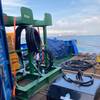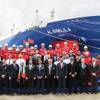Are you LRIT Compliant?
LRIT is approaching fast and with penalties expected for non-compliance the next few months will see a rash of activity as vessel's scramble to find out if their Inmarsat C equipment is already compatible…
The International Maritime Organization (IMO) has adopted an amendment to Chapter V of the International Convention for the Safety of Life at Sea 1974 (SOLAS), which introduces new mandatory position reporting obligations for SOLAS ships. It's called Long Range Identification and Tracking (LRIT) and requires vessels to automatically transmit their identity, position with date/time at 6-hour intervals. Vessels required to comply are:
• Passenger ships, including high-speed craft
• Cargo ships, including high-speed craft, of 300 gross tonnage and upwards
• Mobile offshore drilling units.
LRIT requires a SOLAS vessel to report its identity and position every six hours to the receiving authority, of which there are four:
• Flag State: May track ships within its own fleet anywhere in the world.
• Port State: May set its own requirements for ships that have indicated that they intend to call at its ports.
• Coastal States: May obtain tracking information for ships navigating within a distance up to 1000 nautical miles off their coast (this applies to ships not intending to call and not flying that state's flag - in other words, ships on innocent passage).
• Search and Rescue: Contracting Governments can request information on ships in an area where a Search and Rescue operation is underway
LRIT actually came into force on January 1, 2008, with compliance required by December 31, 2008. But so far, very few vessels have prepared for LRIT and the penalty for non-compliance, although not officially announced, is rumored in some states to be thousands of dollars a day. Quite a hefty penalty for what is in fact, something very simple to comply with.
The low or even no-cost of meeting LRIT requirements comes from the fact that Inmarsat C has been chosen as the main onboard LRIT data provider. It has proven its capabilities in safety and security applications with extensive use for both GMDSS and Ship Safety Alert System (SSAS) and is in fact the only satellite system allowed for GMDSS use.
Thrane & Thrane in is a major manufacturer of Inmarsat C systems and has played a key role in the development of the LRIT standard to ensure that its customer base has been represented right from the beginning. From an end user perspective, the shipowner has to meet the equipment requirements to provide LRIT reporting, however, identity and position reports are made via existing Inmarsat C terminals, so the majority of vessels already have the tools onboard to comply with LRIT.
These terminals have to meet a certain performance standard to be suitable for LRIT use. Ship LRIT equipment must be capable of being configured to transmit the following minimum information in an Automatically Generated Position Report (APR):
• Ship identity
• Ship position
• Date and time of the position.
Although automatic six hour reporting is the core of LRIT, the system has been designed to be as flexible as possible. Ship LRIT equipment must be able to respond to requests from member states and LRIT data centers for immediate position reports and be able to change the time interval between reports to a maximum frequency of every 15 minutes. Most Inmarsat C terminals are capable of doing this, at least if we look at the thousands of SSAS and GMDSS that Thrane & Thrane has onboard vessels around the world.
Compatibility Testing
How does an operator or owner know if the existing Inmarsat C equipment will meet requirements, especially in the continuing absence of an official test platform for equipment? With the prediction of penalties it is vital to find out if your onboard equipment will work with LRIT but the official testing program may not be active until at least the start of fall 2008, which only leaves a few months before the compliance deadline. There are several unofficial testing services currently available to give an early indication as to compliance, including one that Thrane & Thrane has just launched for users of SAILOR Inmarsat C equipment.
This straightforward test simply requires Thrane & Thrane Inmarsat C GMDSS and SSAS owners to contact their local distributor to organise the testing. Thrane & Thrane engineers will carry out the remote testing and inform the customer if their equipment is LRIT compatible. It is though important to stress that currently, this is not the final approval, as this can only be issued by the flagstate. The test simply gives an indication of compliance, which enables action to be taken if the equipment is not LRIT compatible.
Thrane & Thrane predicts that a certain percentage of existing Inmarsat C terminals will not be suitable for LRIT unless updates are applied. It is possible that a specific configuration or minor installation problems can affect a terminal's ability to transmit the LRIT signals, and in the case of a system that fails the testing, Thrane & Thrane will provide a software update where possible, though some customers may choose the new low-cost SAILOR TT-3000 LRIT, one of few standalone LRIT terminals coming to market.
LRIT promises to provide a much clearer picture of merchant shipping activity to key stakeholders. The system has the potential to increase safety and security and by giving Port States early indication of a vessel's position and route details, it could even provide a more seamless experience from deep sea, to coastal passage and port approach right up to dockside. And for once, a new regulation may not require any significant investment from ship owners or operators but in order to find out and ensure plenty of time to make any necessary changes, testing has to be done as soon as possible.
www.thrane.com/Maritime/Introduction/LRIT.aspx
About the Author
Henrik Dryholm is Market Development Manager for Tracking at leading satellite equipment manufacturer Thrane & Thrane. As the company's tracking specialist he has played a part in the LRIT Ad Hoc Working Group under the IMO since his first meeting with the group in May 2006.
(Reprinted from the August 2008 edition of Maritime Reporter & Engineering News)












